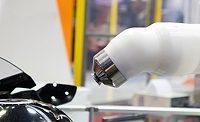How Is the Aerospace Industry Sending the High-Temperature Coatings Market to New Heights?

Aerospace coatings are carefully chosen to offer reliable performance in demanding conditions. High-temperature coatings are instrumental in giving the desired protective effects. As a result, the increased application of these products in the aerospace sector helps the specialty coatings market gain impressive traction and growth. Here are some reasons why that’s the case.
1. A Continued Desire for Engine Efficiency
A primary reason for the aerospace sector driving the high-temperature coatings market’s success is an ongoing need to do whatever is feasible to make engines last longer and consistently show efficient performance. Thermal barrier coatings (TBCs) can achieve those aims and others.
A report from Grandview Research confirmed that the aerospace industry topped the market in 2020. The applications of these coatings accounted for a revenue share of more than 31%. The report’s authors also said the global TBC market was worth $15.49 billion in 2020. Over the forecast period of 2021-2028, it would achieve a compound annual growth rate of 4.8%.
They clarified that increased demand within the aerospace sector and other industries, including automotive and energy, was one of the significant drivers of the growth. However, when the researchers narrowed their focus to what’s causing momentum in aerospace, they discussed how people often apply ceramic TBCs to gas turbines. Doing that lets them operate at higher temperatures and reach improved efficiencies.
The report also mentioned the rise in consumer air traffic. Coping with that phenomenon means developing new processes and technologies that help airplane parts perform better for longer. TBCs connect to that aim. The authors clarified that air travel would particularly excel in North America. High levels of disposable income, skilled labor forces and a strong North American economy were some of the reasons for the ongoing interest in air travel.
Airlines can better meet consumer demand for new routes and improve flight availability when planes operate efficiently. Although most people won’t realize how high-temp coatings impact their trips, the people who design and manufacture aircraft keep that matter a top-of-mind concern.
2. The Ongoing Development of New Coatings Spurs Growth
People in the market for aerospace coatings have high expectations and specific needs. That’s why efforts to engineer new options go through rigorous research and development processes that include laboratory testing to ensure pioneering coatings hold up to expected real-world conditions. Testing a coated material’s properties at temperatures higher than ambient provides development teams with valuable insights, letting them ensure their products meet or exceed a customer’s expectations.
A report from Transparency Market Research indicated that quality was the most significant preference for people buying these coatings. Thus, the teams creating new options must keep this at the center of those efforts. The authors also noted that temperature variations in the air mean coatings must protect the aircraft from unwanted effects, such as corrosion.
How Do Coatings Make Airplanes More Sustainable?
Besides quality, people increasingly want products that help airlines meet environmental sustainability goals. It’s widely known that planes are not the most eco-friendly way to travel. However, specialty coatings have become a factor in the search for greener airplane materials.
As mentioned earlier, people use heat-resistant coatings to get better efficiency. However, you may not realize the temperatures inside a jet engine’s combustion chamber can reach almost 1,400 C. Newer engines have higher fuel compression and chamber temperatures, making it even more necessary to ensure these coatings make planes more sustainable.
People have also looked for replacements for hexavalent chromium. It was once the top corrosion inhibitor used on planes but is now classified as a known carcinogen. It risks the health of people exposed to it and harms the environment. The search for chromium-free options has also had an outcome you may not expect. It often makes the coated parts lighter, which reduces how much fuel the plane uses.
Robin Peffer, global marketing manager for aerospace coatings company PPG Industries, explained, "So if we have a primer that's 20% or 30% lighter than standard chromated primers today, that's going to have a direct impact on fuel efficiency for the aircraft." Peffer continued by explaining how immersing parts in coating achieves optimal outcomes, saying, "We can get upwards of 75% or more weight savings because we're putting the coating on more uniformly across the part than we can with spray."
3. Aerospace Coatings Boost Resilience
Zinc is often used to galvanize other metals to make them resist corrosion. For example, steel and iron structures or components frequently exposed to the elements are often treated with zinc first. However, its potential benefits span beyond safeguarding against corrosion.
Several decades ago, employees at the Goddard Space Flight Center developed a zinc powder and potassium silicate blend. Research showed that the coating did more than cover the underlying metal to protect it. It also chemically bonded with the base surface. NASA later used it on seaside structures at the Kennedy Space Center after representatives realized it protected against the high-temperature conditions of rocket launches.
There’s also an ongoing demand for pretreatment coatings during manufacturing. Zinc-chromate is a common aircraft primer. It gives planes a green or yellow color before they are painted.
Zinc-chromate is not typically among the high-temp coatings. However, you can buy resins that are better engineered for higher heat. There’s also more recent research about two-pack solvent-based polyester polyurethane coatings for military aircraft. Tests subjected them to temperatures of 120 C for an hour. An examination showed they held up well, and the heat did not affect on the coating’s gloss or color.
A Broader Look at the Pretreatment Coatings Market
A Global Market Insights report mentioned that the pretreatment coatings market worth exceeded $11 billion in 2019. Additionally, the authors expected a compound annual growth rate of more than 5.1% over the studied period of 2020-2026. They mentioned that the aerospace sector would show a compound annual growth rate of at least 5% during that time.
The report also discussed how these coatings appeal to the commercial aviation sector since they “increase protection against environmental susceptibilities in difficult conditions.” The authors believed that characteristic would be a vital factor in the market’s growth. They also brought up Europe as a region where the aerospace industry would be particularly instrumental in the coating sector’s success.
Additionally, part of the report covers pretreatment coatings for aluminum surfaces. The authors said, “[T]heir high-performance characteristics also help in increasing workability under high thermal stress and pressure.” They cited those factors as also accelerating growth for the coatings market, even beyond applications in the aerospace sector.
High-Temp Coatings Remain Crucial for Aerospace
Today’s planes and spacecraft models must tolerate incredibly challenging conditions. High-temp coatings are not the only aspects that help them perform well for their expected useful life spans, but they’re critical elements.
The analyses covered here give a valuable look into why the aerospace industry is such a substantial factor in helping the coatings market grow. That will remain true for at least the next several years and perhaps even longer as aerospace designs become more advanced.
Looking for a reprint of this article?
From high-res PDFs to custom plaques, order your copy today!







